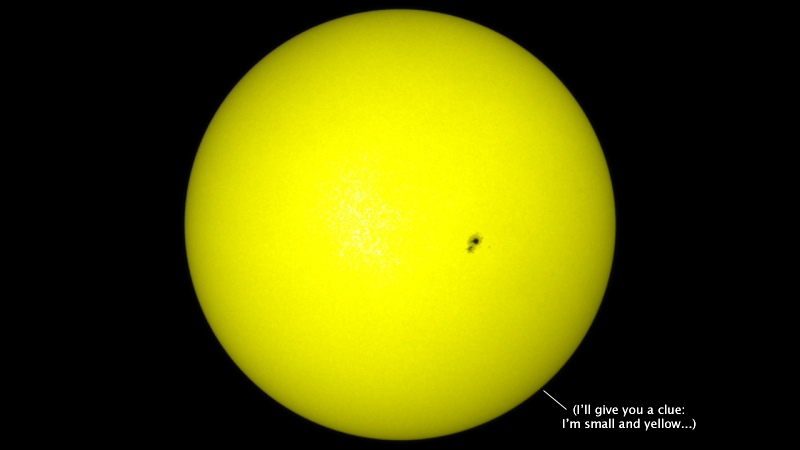
Our Sun is often called an “average” or “unremarkable” star. This is a little unfair, after all this unremarkable specimen is responsible for generating all the energy for all the planets in the Solar System and it has nurtured life on Earth for the past four billion years. We are also very lucky in that the Sun (or “Sol”) is comparatively stable with a periodic cycle. What’s more, it is alone, with no binary partner complicating matters. We live in a very privileged corner of the Milky Way, within the “Goldilocks Zone” (i.e. “just right” for life – as we know it – to thrive) from Sol, where there is a unique and delicate relationship between our star, the Earth and interplanetary space. This is all great, but in the star club, how does Sol measure up? Is it really just an average, boring star?
I noticed in the comments of my article Observing an Evaporating Extrasolar Planet that some readers were discussing the classification of our Sun. This was in response to the subject of the exoplanet called HD 209458b orbiting the yellow dwarf star HD 209458 in the constellation of Pegasus. I happened to point out that HD 209458 was “…not too dissimilar to our Sun (with 1.1 solar masses, 1.2 solar radii and a surface temperature of 6000 K),” but also highlighted that HD 209458 was a yellow dwarf star. To be honest, I didn’t think about the connection until Jerry Martin asked why our Sun is never referred to as a yellow dwarf star? Helpfully, Dave Finton posted a link to Wikipedia that discusses this topic. For the full wiki treatment, have a look at Wikipedia:G V star, otherwise read on…

In the Hertzsprung-Russell Diagram, all known stars fall into one of six broad classifications depending on their luminosity and surface temperature. Observed stars can either be classed as (from big to small) a super-giant, bright giant, giant, sub-giant, main sequence or white dwarf. Within those classifications are spectral sub-classes from “O” (surface temperature of 30,000K), “B”, “A”, “F”, “G”, “K” to “M” (at 3,000K). However, for the sake of keeping this article on-topic, we’ll focus on our star, Sol (which is Latin for Sun).
Granted, our Sun has a surface temperature of around 6,000K, giving it a spectral classification of “G”. On the luminocity scale, our Sun scores a “V”. So, the Earth orbits a “G V star” which is otherwise known as a Yellow Dwarf star (although their actual colour ranges from white to slightly-yellow). Why is Sol considered to be “average”? That’s because in the Hertzsprung-Russell Diagram, yellow dwarfs can be found right smack-bang in the centre of the chart, half-way down the Main Sequence. Using this chart gives an idea about where our star came from and where it is going. For the moment, it is a hydrogen-burning star, converting 600 million tonnes of hydrogen into helium per second. This “hydrogen burning phase” generally lasts for about 10 billion years (Sol is about half-way through this phase) until all the hydrogen fuel is exhausted. When this happens, a yellow dwarf will puff up into a Red Giant, eventually shedding its outer layer, producing a planetary nebula. Eventually, the core will cool and compress into a long-living white dwarf star.
So, to answer the question, the Sun is a yellow dwarf star… and it certainly is not unremarkable…

Awesome article – whatever you do, don’t stop writing great stuff like this!
Question though – and alas, I’m not going to be around to witness it, but what happens to little old earth (assuming we haven’t blown it up before then) when our sun changes into a red dwarf?
I’m assuming that once it does go through the dramatic shift from it’s current yellow dwarf like state to a red dwarf, we’re talking about a significant increase in physical size, and surely that’s going to have broad ranging effects on anything still trying to live on planet earth?
There’s a whole heap of issues such as temperature change and solar winds etc etc that we’ll surely go through, but if and when the inhabitants of planet earth survie that whole mess, I’m curious about what happens to the “habitable zone” ( goldilocks zone as you put it ) – any ideas?
cheers,
++Dez;
http://www.blanchfield.com.au/
http://www.thestorageforum.com/
http://www.websearch.com.au/
http://www.cradletechnologies.com/
Our Sun is officially a class G2 V star to be precise. Although there is some controversy about this as the solar spectrum might actually be closer to that of a typical G3 or even G4 star. See:
http://adsabs.harvard.edu/abs/1992PASP..104.1035G
This is an amateur article for amateur readers.
WRONG
rofl! Thanks Benia, you sound like a quality individual. Right back at ya!
Funniest thing I’ve read all day 😀
I'm reasonably sure that you can't say that an infinite universe implies that anything that can happen, does happen, multiple times.acnee
I'm reasonably sure that you can't say that an infinite universe implies that anything that can happen, does happen, multiple times.acnee
are ther any other stars similar to our sun?
hi
ytyytygtfhydl,m ,n smnnbtfhijwfKJMUFCRVGBHKNM
omg that was great
this website doesnt help me at all